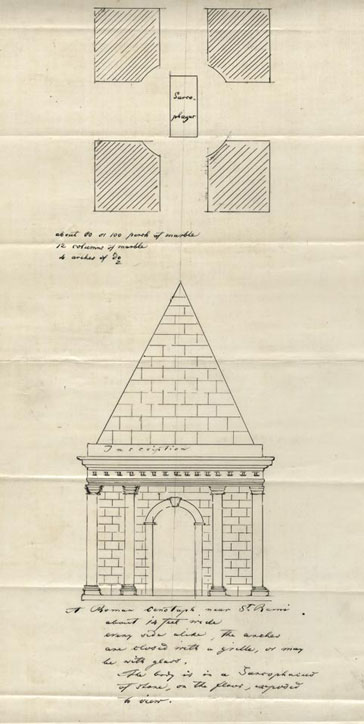On 5 July 1858, the remains of former President James Monroe were transported aboard the Jamestown amid much ceremony from New York City’s Marble Cemetery to Hollywood Cemetery in Richmond, Virginia. Then governor Henry A. Wise had engineered the return of Monroe’s remains to his native Virginia. Wise’s Executive Papers contain correspondence between Daniel F. Tiemann, Mayor of New York City, and Samuel L. Gouverneur, Jr., son-in-law of James Monroe, regarding arrangements for the reburial. Architect Albert Lybrock’s design of a cast-iron monument for Monroe’s tomb is also included with these papers.
A lesser-known effort also initiated by Wise was his unsuccessful attempt to have Thomas Jefferson’s remains relocated from the family cemetery at Monticello to Hollywood Cemetery. On 26 June 1858, Governor Wise wrote a letter to Charles C. Wertenbaker, 1st Lieutenant of the Monticello Guard and Chairman of the Committee of Arrangements at Monticello. The Governor wished to receive the consent of Thomas Jefferson Randolph to remove the remains of Thomas Jefferson on July 3rd and deposit them next to those of James Monroe at Hollywood.
Wertenbaker’s return letter communicated Randolph’s disapproval of the plan, citing Jefferson’s wish to be buried next to his wife and daughter. In a letter to the Governor, George W. Randolph expressed his disagreement with his brother, but Jefferson’s remains were never laid to rest next to those of Monroe.
In the same letter to the Governor, Wertenbaker requested assistance in raising a subscription to build a suitable monument over Jefferson’s grave at Monticello. He enclosed a plan of a Roman cenotaph near St. Rémy, France, drawn by Thomas Jefferson while serving as Minister of France. The plan, which was lent to him by T. J. Randolph, was later copied onto a sheet of tracing linen and the original returned by the Governor a year later after polite prodding by Wertenbaker. Wertenbaker even offered to send the Governor an autograph letter of Thomas Jefferson in exchange for the drawing.
Like the removal of Jefferson remains, the construction of the cenotaph over Jefferson’s grave was never accomplished. Instead, the present obelisk structure on his grave at Monticello replaced the original marker, which was presented to the University of Missouri on 4 July 1883.
-Craig Moore, Senior State Records Appraisal Archivist









What part of “Laid to Rest” don’t people understand? Is this for bragging rights?
Yes, it is for bragging rights, and this isn’t the only time the state attempted to disinter a former president. On 16 February 1816 the General Assembly passed a resolution authorizing the governor to inquire of Bushrod Washington whether he and his family would permit the remains of George and Martha Washington to be removed from the vault at Mount Vernon and placed in a monument to be built in Richmond by public subscription. Although the Washington family refused to grant permission to transfer the remains, popular support for a proposed Washington monument in Richmond resulted in the collection of a large sum of money. On 22 February 1828 the General Assembly authorized the governor to invest the money in state stock as the Washington Monument Fund. Several plans for the monument were considered before that of Thomas Crawford, of Philadelphia, was accepted. His equestrian monument to George Washington was unveiled in Capitol Square on 22 February 1858.
Craig,
Why was the original marker sent to the U of MO? We are from MO and were never aware of this fact.
The University of Missouri was chosen because it was the first state university within the Louisiana Purchase. The following website provides a good explanation (http://www.waymarking.com/waymarks/WM3M5H_Thomas_Jefferson_Original_Grave_Stone_University_of_Missouri_Columbia_Missouri).